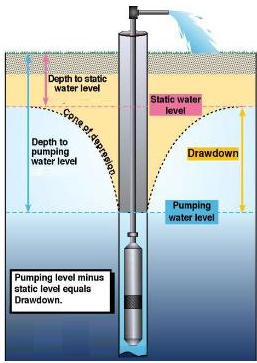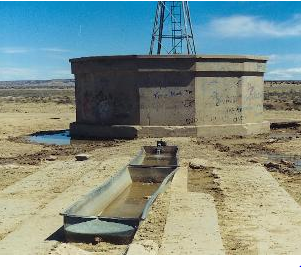Throughout the world, especially in developing Indian Countries, there is a dire need for water to fulfill basic human self-sufficiency demands. In most cases, the problem is not the lack of available water, but the inability to obtain it in a cost-effective, reliable manner.
The most common method currently used to extract water from the Navajo Nation is through the use of submersible pumps, open wells, and
spring boxes. The disadvantages to these methods range from the large amounts of fuel needed to run pumps to sanitary problems and potential disease from open wells.
Most regulated wells provide a clean, safe supply of water; however, contaminants can pollute livestock wells, and unfortunately you cannot see, smell or taste most of them. Consequently, you should test your water on a regular basis. The decision on what to test your water for should be based on the types of land uses near your well. This brochure gives information about several common contaminants found in private wells. It should help you decide when to sample your well and how often, how to find a certified laboratory and who to call for help.


The PWSSP oversees drinking water facilities. A drinking water facility or “public water system” is one that has 15 or more service connections and/or serves more than 25 persons for more than 60 days of te year. The NNSDWA requires that all public water systems monitor for (collect samples and have the samples analyzed) over 72 potential contaminants.
Livestock and Private wells are not regulated by the PWSSP. As a result, the owners and operators of livestock wells are not required to monitor for these 72 contaminants. Because of this, PWSSP recommends that you haul your drinking water from an approved source. The Navajo Tribal Utility Authority maintains watering points where you can purchase safe drinking water.
Please consult with your local community health representative (CHR), clinic and health care provider or the PWSSP for further information.
How Can I Have My Well Tested?
Laboratories use an EPA certified laboratories to test your drinking water for possible contaminants. Navajo EPA PWSSP may help you find a certified laboratory in your area. Laboratories are also listed in the yellow pages of your telephone directory. When you call a laboratory, ask if the lab is certified for the test you want. When your test has been completed, the laboratory will send you the results directly. Navajo EPA-PWSSP would like a copy of the results. The results can contribute to an overall view of the Navajo Nation Water Resources.
Please use the Navajo Nation well ID to specifically identify your well.
What Tests Should Be Done for My Private or Livestock Well?
Coliform bacteria live in soil, on vegetation, and in surface water. Coliform bacteria found in the intestines of warm-blooded animals
and their feces are called Escherichia coli or E. Coli. Some strains of coliform bacteria can survive for long periods in soil and water and
can be carried into well casings by wind or insects. Bacteria washed into the ground by rainwater or snow melt are usually filtered out as
the water seeps through the soil, but they sometimes enter water supplies through cracks in well casings, poorly sealed caps, fractures
in the underlying bedrock, and runoff into sinkholes. Coliform bacteria are the most common contaminant found in livestock water
systems. Most coliform bacteria do not cause illness, but indicate a breach in the water system. However, since E.coli bacteria are found
in fecal material, they are often present with bacteria, viruses and parasites that can cause flu-like symptoms such as nausea, vomiting,
fever and diarrhea. Private wells should be tested at least monthly or quarterly for bacteria, by a laboratory that performs an E.coli test
when total coliform are present. Test again if there is a change in the taste, color, odor or appearance of your water. The coliform test is
one of the most important tests you should have done on your well water. However, bacteria are only one of many possible
contaminants. A negative bacteria test is good news, and means that there are no bacteria in your water. While this is good news, this
does not mean your well is free of other minirals that may cause health problems.
Nitrate forms when nitrogen from fertilizers, animal wastes, septic systems, decaying plants and other sources combines with
oxygenated water. Also nitrogen competes with oxygen in your blood and causes health problems. Infants under six months of age,
nitrate exposure can cause a serious condition called methemoglobinemia or “blue-baby syndrome.” Infants with this condition need
immediate medical care because it can lead to coma or death. Pregnant women may not have the proper amount of oxygen available to
the growing fetus if they drink water containing nitrate. Everyone should have their water tested for nitrate at least once. Well owners
should also test for nitrate regularly if their well is located near an animal waste or septic area. In general, shallow wells and wells with
short or cracked casings have the highest risk of contamination, however deep wells are also at risk in some areas.
Arsenic occurs at some area of low levels in soil and bedrock, but has been found at levels above drinking water standards in the
Navajo Nation. Long term exposure to arsenic at high levels can result in nervous, digestive system problems and to skin cancer.
Radionuclides is a radioactive element found in soil and bedrock that can be released into groundwater. Radionuclides levels above the
drinking water standard have been detected in parts of the Navajo Nation where wells draw water from shallow or deep formations.
Exposure to high levels of radium over a long period of several years can increase your risk of developing cancer. Consult DNR on
whether to test for radium, if radionuclides were found to be high.
Nuisance bacteria like, iron and sulfur bacteria may also be present in water. Research has determine that these organisms do not
pose a health threat, but they can affect the taste, odor and appearance of water. You may have a nuisance bacteria problem if your water
has a rotten egg smell or if you notice slime in tank. If you suspect a nuisance bacteria problem, try disinfecting the well and water
system.